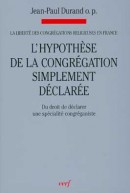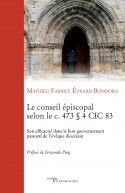
Premier concile plénier chinois — Shangai 1924 (Le)
Collection Droit canonique
416 pages - sept. 2010
46,20€
En 1924, à Shanghai, fut célébré, en pleine communion avec Rome, le premier concile pour la Chine. Les institutions canoniques de l'Église catholique romaine prévoyaient déjà la possibilité de réunir les évêques en concile plénier, c'est-à-dire à l'échelle de tout un pays ; mais tenir de telles assises était et reste de par le monde une initiative extrêmement rare. Cette instance collégiale non permanente peut contribuer à ajuster la pastorale et les œuvres catholiques à la richesse et aux difficultés du contexte local. Ce concile plénier de Shanghai a su adapter le droit canonique missionnaire à la spécificité de la Chine de ce début du XXe siècle. L'évangélisation de l'empire du Milieu, déjà très ancienne, appelait à la fois un bilan, une consécration et une relance. Pendant des siècles, la direction de l'Église locale avait dû compter essentiellement sur de nombreux missionnaires congréganistes étrangers, et avait dû composer avec des présences politiques étrangères, intéressées à maints égards par l'évangélisation de la Chine. Mieux que ses prédécesseurs, le pape Pie XI, alors régnant, était en mesure de convoquer un tel concile : sa vision était de recommander que les autochtones chinois catholiques participent aux décisions canoniques et accèdent bien davantage aux responsabilités ecclésiales les plus grandes. Le concile de Shanghai marque donc une étape importante — et unique — de l'histoire de ce pays et de l'enracinement de cette Église locale, en mettant en quelque sorte un terme à la fameuse querelle des rites chinois qui durait depuis le XVIe siècle. Il contribue, en outre, à l'adaptation du droit canonique missionnaire de l'Église catholique romaine tout entière. Pour situer cet événement, analysé en détail du point de vue de son originalité juridique, l'auteur retrace dans une vaste fresque la très longue évolution religieuse de la Chine, avec l'éminente et délicate rencontre entre le confucianisme et les différentes présences chrétiennes en Chine depuis des siècles.
--
In 1924, in Shanghai, the first Plenary Council for China took place in communion with Rome. The canonical institution of the Roman Catholic Church, even then, foresaw the possibility of uniting bishops at a plenary council, i.e. on a national scale. But to hold such an assembly was, and remains, an exceptional initiative. This non-permanent collegiate instance can help adapt pastoral work and Catholic activities to the richness and the difficulties of a local context, and the Plenary Council of Shanghai succeeded in adapting canonical missionary law to the specificity of China at the beginning of the 20th century. The evangelization of the Middle Kingdom, which had begun long before, then required appraisal, consecration and a relaunch. For centuries, the direction of the Church in China had been obliged to rely essentially on many foreign congregational missionaries, and to deal with foreign political powers who took great interest in the evangelization of China. More than his predecessors, the Pope at that time - Pius XI - was capable of summoning such a council: his vision was to recommend that Chinese Catholics should participate in the canonical decisions and gain access to greater ecclesial responsibilities. So the Council of Shanghai marked an important and unique development in the history of this country and the establishment of the local Church, by putting an end to the famous quarrel of Chinese rites that had lasted since the 16th century. It also contributed to adapting the canonical missionary law of the entire Roman Catholic Church. To situate this event, analysed in detail from the viewpoint of its juridical originality, the author paints a vast fresco of China’s very long religious evolution, with its renowned and subtle encounter between Confucianism and the various Christian presences that had been in China for centuries.
--
In 1924, in Shanghai, the first Plenary Council for China took place in communion with Rome. The canonical institution of the Roman Catholic Church, even then, foresaw the possibility of uniting bishops at a plenary council, i.e. on a national scale. But to hold such an assembly was, and remains, an exceptional initiative. This non-permanent collegiate instance can help adapt pastoral work and Catholic activities to the richness and the difficulties of a local context, and the Plenary Council of Shanghai succeeded in adapting canonical missionary law to the specificity of China at the beginning of the 20th century. The evangelization of the Middle Kingdom, which had begun long before, then required appraisal, consecration and a relaunch. For centuries, the direction of the Church in China had been obliged to rely essentially on many foreign congregational missionaries, and to deal with foreign political powers who took great interest in the evangelization of China. More than his predecessors, the Pope at that time - Pius XI - was capable of summoning such a council: his vision was to recommend that Chinese Catholics should participate in the canonical decisions and gain access to greater ecclesial responsibilities. So the Council of Shanghai marked an important and unique development in the history of this country and the establishment of the local Church, by putting an end to the famous quarrel of Chinese rites that had lasted since the 16th century. It also contributed to adapting the canonical missionary law of the entire Roman Catholic Church. To situate this event, analysed in detail from the viewpoint of its juridical originality, the author paints a vast fresco of China’s very long religious evolution, with its renowned and subtle encounter between Confucianism and the various Christian presences that had been in China for centuries.
- Dimensions : 135x215x30
- ISBN : 9782204092050
- Poids : 540 grammes
DANS LA CATÉGORIE LE MAGISTÈRE
Vie religieuse, érémitisme, consécration des vierges, communautés nouvelles
de Comité canonique de la CORREF
256 pages - sept. 1993
Le conseil épiscopal selon le canon 473 alinéa 4 CIC 83
de Mathieu Fabrice Évrard Bondobo
278 pages - mars 2016
Recueil des accords en vigueur entre la France et le Saint-Siège
d' Emmanuel Tawil
292 pages - mai 2017






